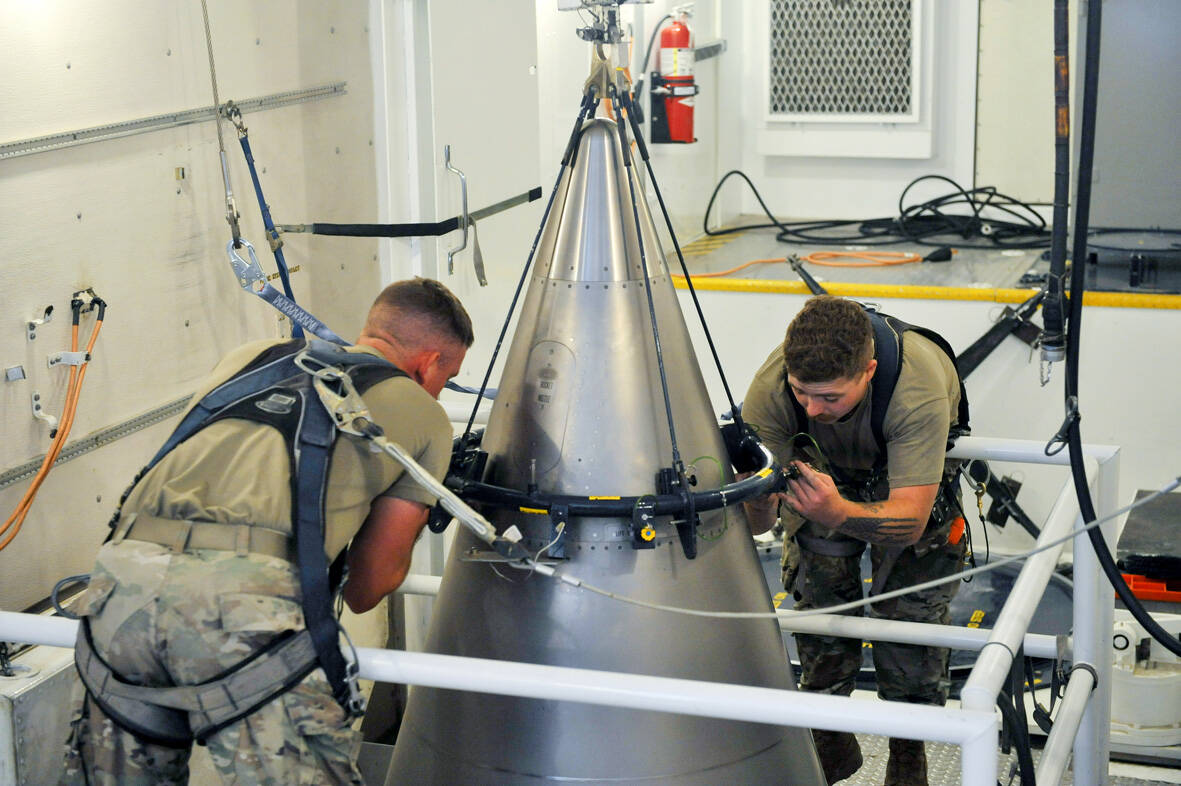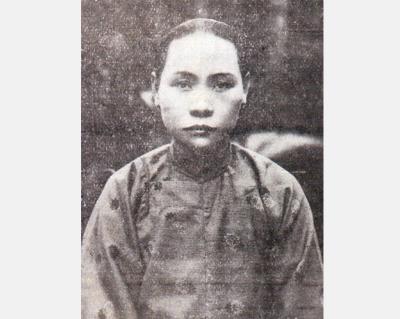The US will spend more than US$750 billion over the next decade to revamp nearly every part of its aging nuclear defenses. Officials say they simply can’t wait any longer — some systems and parts are more than 50 years old.
For now, it’s up to young military troops and government technicians across the US to maintain the existing bombs and related components. The jobs are exacting and often require a deft touch. That’s because many of the maintenance tasks must be performed by hand.
The Associated Press was granted rare access to nuclear missile bases and weapons production facilities to see how technicians keep the arsenal working while starting the government’s biggest nuclear overhaul since the Cold War.

Photo: AP
This is how they do it and who they are:
SHAKE, RATTLE AND ROLL
Because the US no longer conducts explosive nuclear tests, scientists are not exactly sure how aging warhead plutonium cores affect detonation. For more common parts, like the plastics and metals and wiring inside each detonator, there are also questions about how the years spent in warheads might affect their integrity.
So workers at the nation’s nuclear labs and production sites spend a lot of time stressing and testing parts to make sure they’re safe. At the Energy Department’s Kansas City National Security Campus, where warheads are maintained and made, technicians put components through endless tests. They heat weapons parts to extreme temperatures, drop them at speeds simulating a plane crash, shoot them at high velocity out of testing guns and rattle and shake them for hours on end. The tests are meant to simulate real world scenarios — from hurtling toward a target to being carted in an Air Force truck over a long, rutty road.
Technicians at the Los Alamos National Lab conduct similar evaluations, putting plutonium under extreme stress, heat and pressure to ensure it is stable enough to blow up as intended. Just like the technicians in Kansas City, the ones in Los Alamos closely examine the tested parts and radioactive material to see if they caused any damage.
RELYING ON OLD BLUEPRINTS
The lack of explosive tests — banned since the George H.W. Bush administration by an international treaty — has also meant that the scientists have been forced to rely on warhead designs that were created many decades ago.
That’s because each of those original designs had been certified, and the best way to certify a weapon works as designed is to blow it up. Changing even one component introduces uncertainty.
Further complicating matters — because the weapons are so old — many of those original manufacturers and contractors have gone out of business. That has forced the nation’s nuclear labs to reverse engineer old parts, such as a peroxide that was used to treat warhead parts, but is no longer in production. So lab technicians are working to reinvent it.
Re-engineering parts is getting easier with advances in computer-aided design and 3D printing. Kansas City technicians are experimenting with 3D printers to create some warhead parts, such as a micro-honeycombed, rubbery layer that will serve as a cushion for a warhead radar systems.
THE WORKERS ARE YOUNGER THAN THE WARHEADS
It’s not unusual to see a 50-year-old warhead guarded or maintained by someone just out of high school, and ultimate custody of a nuclear weapon can fall on the shoulders of a service member who’s just 23.
That is what happened on a recent afternoon in Montana at Malmstrom Air Force Base, where Senior Airman Jacob Deas signed a paper assuming responsibility for an almost 3,000-pound Minuteman III intercontinental ballistic missile warhead, as it was lifted out of the Bravo-9 silo and escorted back to base for work.
A sea swell of government retirements has meant that experience level in the civilian nuclear workforce has shifted dramatically. At the Kansas City campus, for example, just about 6 percent of the workforce has been there 30 years or more — and over 60 percent has been at the facility for five years or less.
That change has meant more women have joined the workforce, too. In the cavernous hallways between Kansas City’s secured warhead workrooms are green and white nursing pods with a greeting: “Welcome mothers.”
At Los Alamos, workers’ uniform allowance now covers sports bras. Why? Because underwire bras were not compatible with the secured facilities’ many layers of metal detection and radiation monitoring.

The Lee (李) family migrated to Taiwan in trickles many decades ago. Born in Myanmar, they are ethnically Chinese and their first language is Yunnanese, from China’s Yunnan Province. Today, they run a cozy little restaurant in Taipei’s student stomping ground, near National Taiwan University (NTU), serving up a daily pre-selected menu that pays homage to their blended Yunnan-Burmese heritage, where lemongrass and curry leaves sit beside century egg and pickled woodear mushrooms. Wu Yun (巫雲) is more akin to a family home that has set up tables and chairs and welcomed strangers to cozy up and share a meal

Dec. 8 to Dec. 14 Chang-Lee Te-ho (張李德和) had her father’s words etched into stone as her personal motto: “Even as a woman, you should master at least one art.” She went on to excel in seven — classical poetry, lyrical poetry, calligraphy, painting, music, chess and embroidery — and was also a respected educator, charity organizer and provincial assemblywoman. Among her many monikers was “Poetry Mother” (詩媽). While her father Lee Chao-yuan’s (李昭元) phrasing reflected the social norms of the 1890s, it was relatively progressive for the time. He personally taught Chang-Lee the Chinese classics until she entered public

Last week writer Wei Lingling (魏玲靈) unloaded a remarkably conventional pro-China column in the Wall Street Journal (“From Bush’s Rebuke to Trump’s Whisper: Navigating a Geopolitical Flashpoint,” Dec 2, 2025). Wei alleged that in a phone call, US President Donald Trump advised Japanese Prime Minister Sanae Takaichi not to provoke the People’s Republic of China (PRC) over Taiwan. Wei’s claim was categorically denied by Japanese government sources. Trump’s call to Takaichi, Wei said, was just like the moment in 2003 when former US president George Bush stood next to former Chinese premier Wen Jia-bao (溫家寶) and criticized former president Chen

President William Lai (賴清德) has proposed a NT$1.25 trillion (US$40 billion) special eight-year budget that intends to bolster Taiwan’s national defense, with a “T-Dome” plan to create “an unassailable Taiwan, safeguarded by innovation and technology” as its centerpiece. This is an interesting test for the Chinese Nationalist Party (KMT), and how they handle it will likely provide some answers as to where the party currently stands. Naturally, the Lai administration and his Democratic Progressive Party (DPP) are for it, as are the Americans. The Chinese Communist Party (CCP) is not. The interests and agendas of those three are clear, but